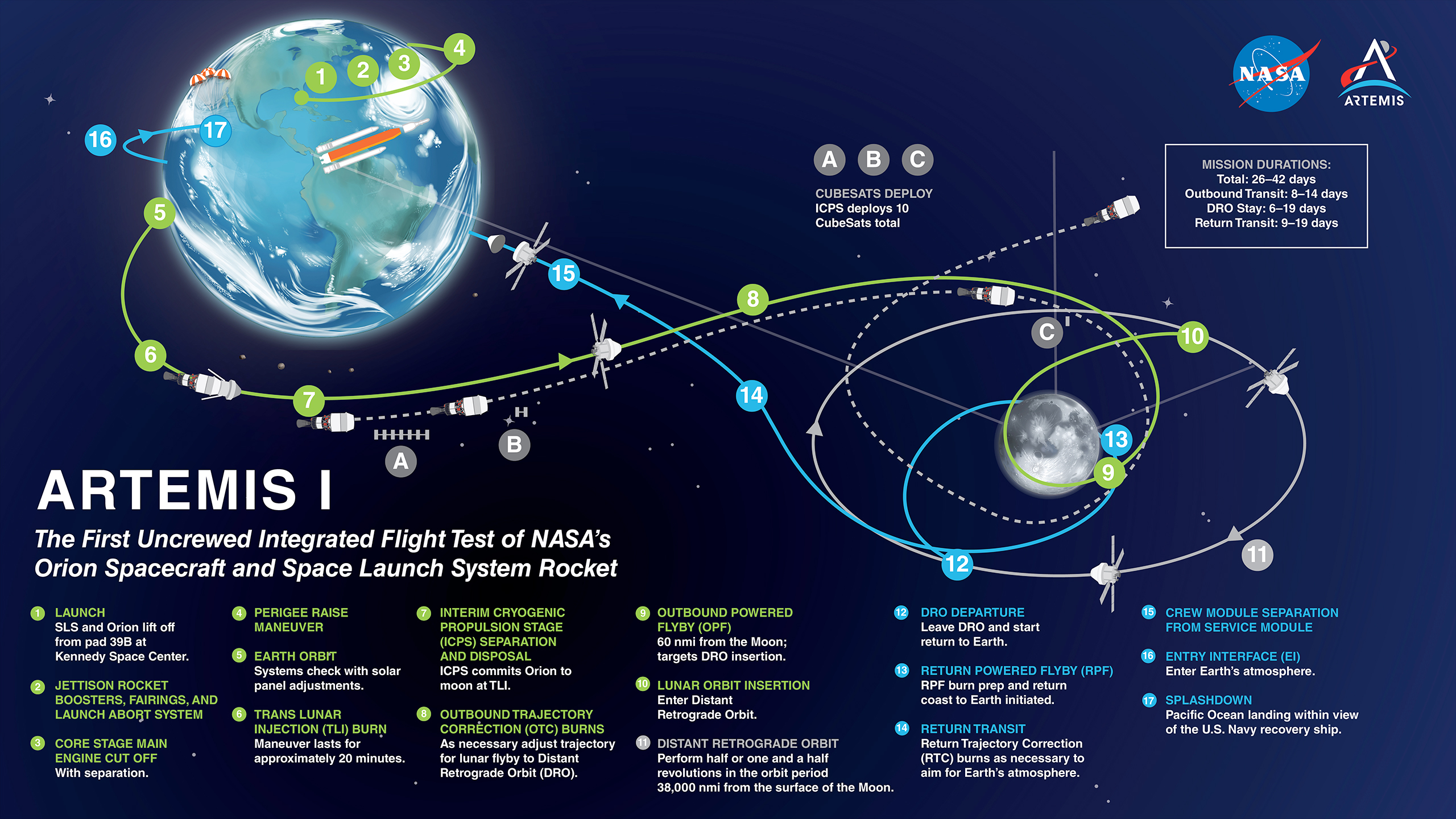NASA’s Artemis I Orion capsule has now traveled farther beyond Earth than any spacecraft designed to carry astronauts.
The uncrewed Orion flew past the record-setting distance (opens in new tab) achieved by the Apollo 13 command module “Odyssey” at 248,655 miles from Earth (216,075 nautical miles or 400,171 kilometers) at about 8:40 a.m. EST (1340 GMT) on Saturday (Nov. 26).
The Apollo 13 spacecraft had previously set the record on April 14, 1970, at 7:21 p.m. EST (0021 GMT on April 15).
“It didn’t register [with] me then. We were so busy with our heads down that we just didn’t have time to think about it,” Gerry Griffin, former flight director who helped lead Mission Control during the Apollo 13 mission, said in a NASA-led Twitter Spaces panel discussion (opens in new tab) on Tuesday (Nov. 12). “In fact, until just about a year ago, I had no idea we had gone the farthest from Earth on Apollo 13. I figured we’d done it on some other mission.”
Related: NASA’s Artemis 1 moon mission: Live updates
More: 10 wild facts about the Artemis 1 moon mission
The original flight plan for Apollo 13 did not have the spacecraft traveling so far away. As is now widely known (having been depicted in a 1995 Hollywood movie), the mission suddenly switched from targeting a moon landing to safely bringing the astronauts back to Earth after a mid-flight explosion tore through the vehicle’s service module.
Apollo 13 reached the distance it did because there was an emergency need to use the moon’s gravity to slingshot the spacecraft back to Earth as quickly and as safely as possible.
Similarly, the Artemis I flight profile was not designed specifically to break the Apollo 13 record. It only did so because NASA sent the Orion into a lunar distant retrograde orbit.
“Artemis I was designed to stress the systems of Orion and we settled on the distant retrograde orbit as a really good way to do that,” said Jim Geffre, NASA’s Orion spacecraft integration manager. “It just so happened that with that really large orbit, high altitude above the moon, we were able to pass the Apollo 13 record. But what was more important though, was pushing the boundaries of exploration and sending spacecraft farther than we had ever done before.”
Orion did not stop at the Apollo 13 distance. NASA expects the Artemis I capsule to reach a maximum distance from Earth of 268,553 miles (432,194 km) at 4:06 p.m. EST (2106 GMT) on Monday (Nov. 28). From there it will continue traveling halfway around the moon until firing its orbital maneuvering system engine (opens in new tab) to leave the distant retrograde orbit, setting up its second close pass to the lunar surface (opens in new tab) on Dec. 5, followed by its return to Earth on Dec. 11.
Related: The Apollo Program: How NASA sent astronauts to the moon
The Apollo 13 record is not the only connection Artemis I has to the 1970 mission.
Although Orion does not have a crew, it is flying instrumented manikins to measure radiation exposure and the stresses a crew member would experience on a flight to the moon and back. One of the stand-ins, the only-full body example, was named “Commander Moonikin Campos” (opens in new tab) after the late Arturo Campos, who during the Apollo 13 mission wrote the emergency procedures to transfer power from the Apollo lunar module batteries to the command module, enabling Odyssey to have enough electricity to reach a safe splashdown (opens in new tab).
Campos, who died in 2004, was the electrical power subsystem manager for the lunar module, and his colleagues in the Mission Evaluation Room and Mission Operations Control Room were awarded the Presidential Medal of Freedom for their efforts.

As “Moonikin Campos” is not a real person, the Apollo 13 astronauts (opens in new tab) — James Lovell, Fred Haise and Jack Swigert — still hold the Guinness World Record (opens in new tab) for the “farthest distance from Earth reached by humans” at 248,655 miles (400,171 km). That may change though when NASA launches its next Artemis mission — the first to carry astronauts — tentatively slated for 2024.
“We may or may not break Apollo 13’s human spaceflight distance record, but won’t know until after we launch,” Laura Rochon, a NASA’s public affairs specialist, told collectSPACE.com. “Artemis II is a high Earth orbit, followed by a free return flyby of the moon. The Earth to moon distance is anywhere from 221,500 miles at perigee to 252,700 at apogee [356,500 to 407,700 km]; flyby altitudes range from about 4,000 to 12,000 miles [6,400 to 19,000 km] on the far side of the moon, so the total could be anywhere from around 225,500 to 265,000 miles [363,000 to 426,500 km] depending on launch date.”
There is a NASA spacecraft that once carried a crew and has since traveled well beyond the Apollo 13 distance from Earth, having entered a heliocentric orbit. The Apollo 10 lunar module (“Snoopy (opens in new tab)“) ascent stage would be the record holder today if it had been designed to carry humans to the Sun and its placement into a disposal orbit had not been after its use by the Apollo 10 crew was over, according to NASA.
collectSPACE is grateful to film and TV company Haviland Digital (opens in new tab) for supporting our Artemis I coverage. Their team has produced and supported titles such as the award-winning “Last Man on the Moon,” “Mission Control: The Unsung Heroes of Apollo” and “Armstrong.”
Follow collectSPACE.com (opens in new tab) on Facebook (opens in new tab) and on Twitter at @collectSPACE (opens in new tab). Copyright 2022 collectSPACE.com. All rights reserved.

